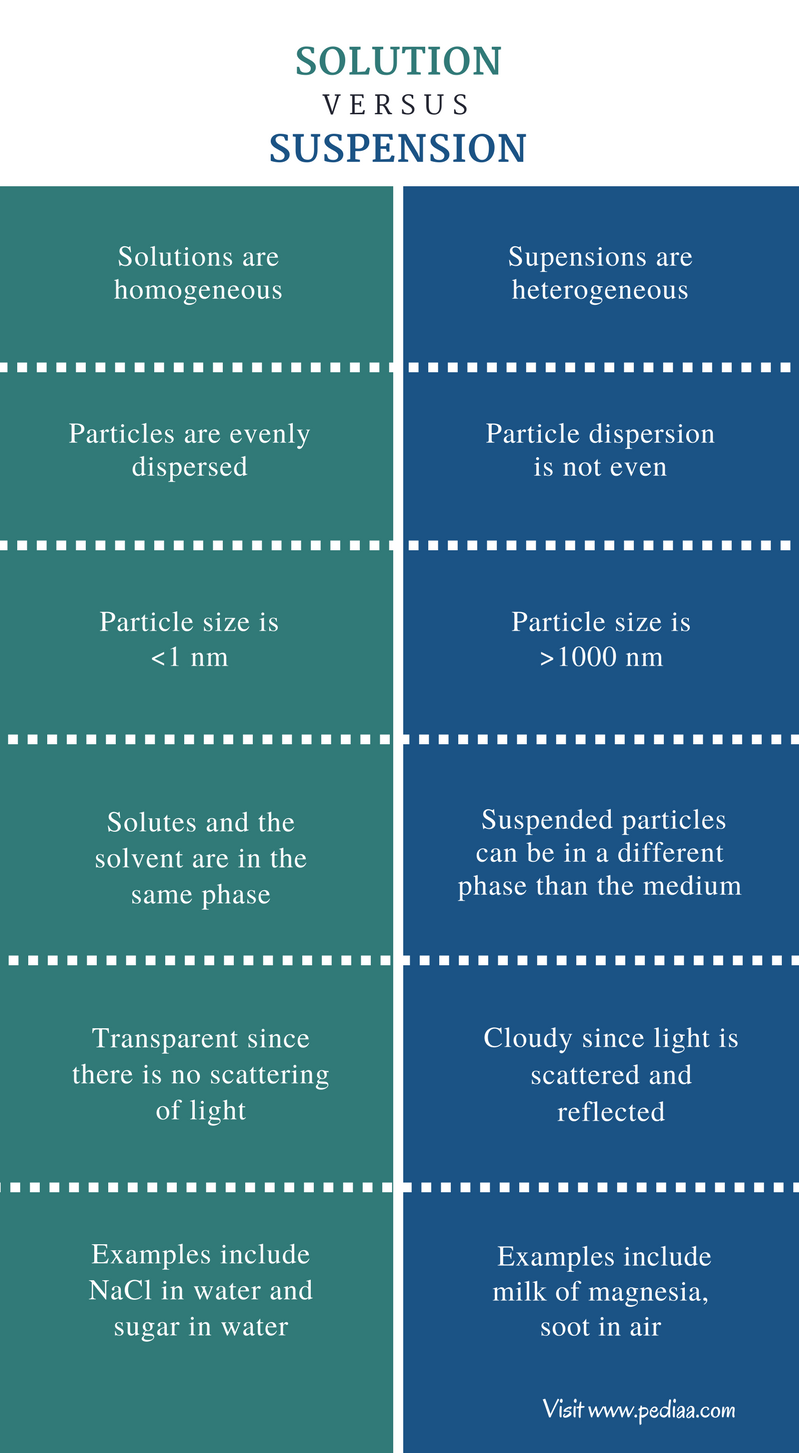
Difference Between Solution and Suspension Definition
Suspensions - A mixture that contains solid particles large for sedimentation. Emulsions - A mixture of two or more liquids that are unmixable. FACT: Water is considered a universal solvent. It has the ability to dissolve more substances than any other solvent.

PPT Solution and Suspension PowerPoint Presentation, free download
Most people are confused about what suspension solution is. Suspensions are obtained when insoluble solid particles are dispersed in a liquid medium. On shaking the solute particles can be evenly dispersed in the medium but if left undisturbed the solute particles which range from 0.5 to 5 μm tend to settle down and can be separated from the.

abri Réfléchi Labyrinthe solution suspension colloid mental Tout faire
Solution vs suspension As shown above, a solution consists of a solute dissolved in a solvent. This means that particles of the solute have been surrounded by solvent particles. This is a homogenous mixture. In contrast, a suspension is a mixture in which one component is not dissolved in the other. For example, sand and water.
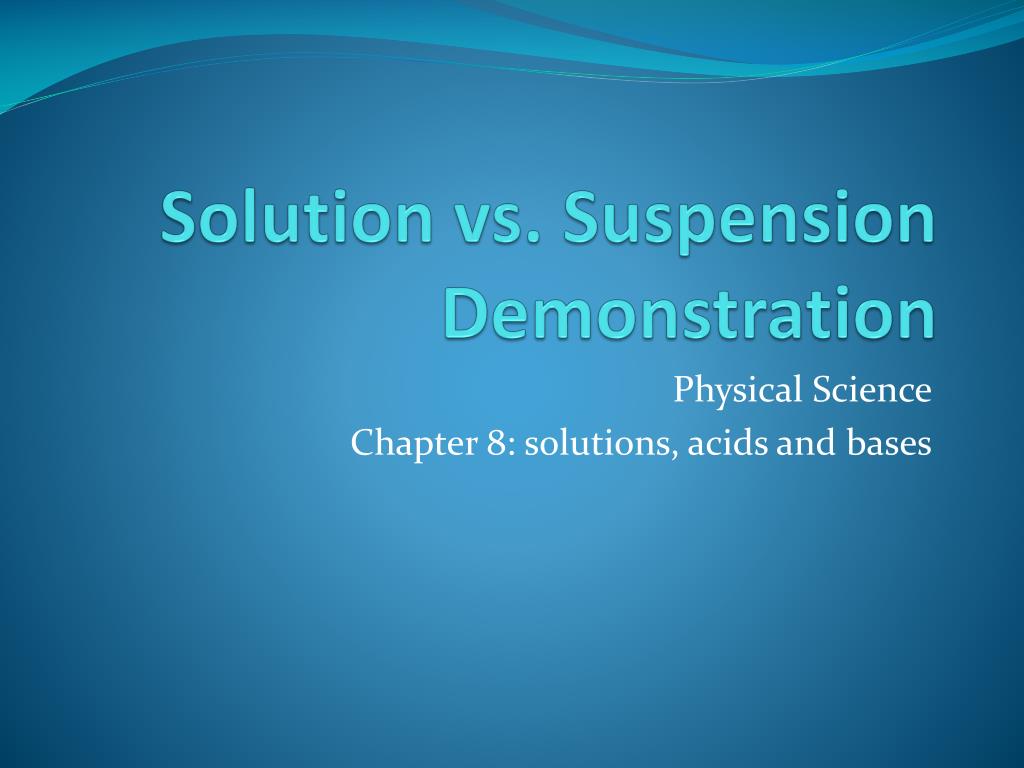
PPT Solution vs. Suspension Demonstration PowerPoint Presentation
Both solutions and suspensions are mixtures of two or more components and neither of them have components that are chemically bonded together. Components in both a solution and a suspension can be separated based on their physical properties of density, solubility or size. What Are Examples of Solutions?

Difference between Solutions and Suspensions Lesson Plan Coaches
What is the difference between a solution and a suspension? A solution is a homogeneous mixture where one substance dissolves into another and stays mixed together. A suspension is a.
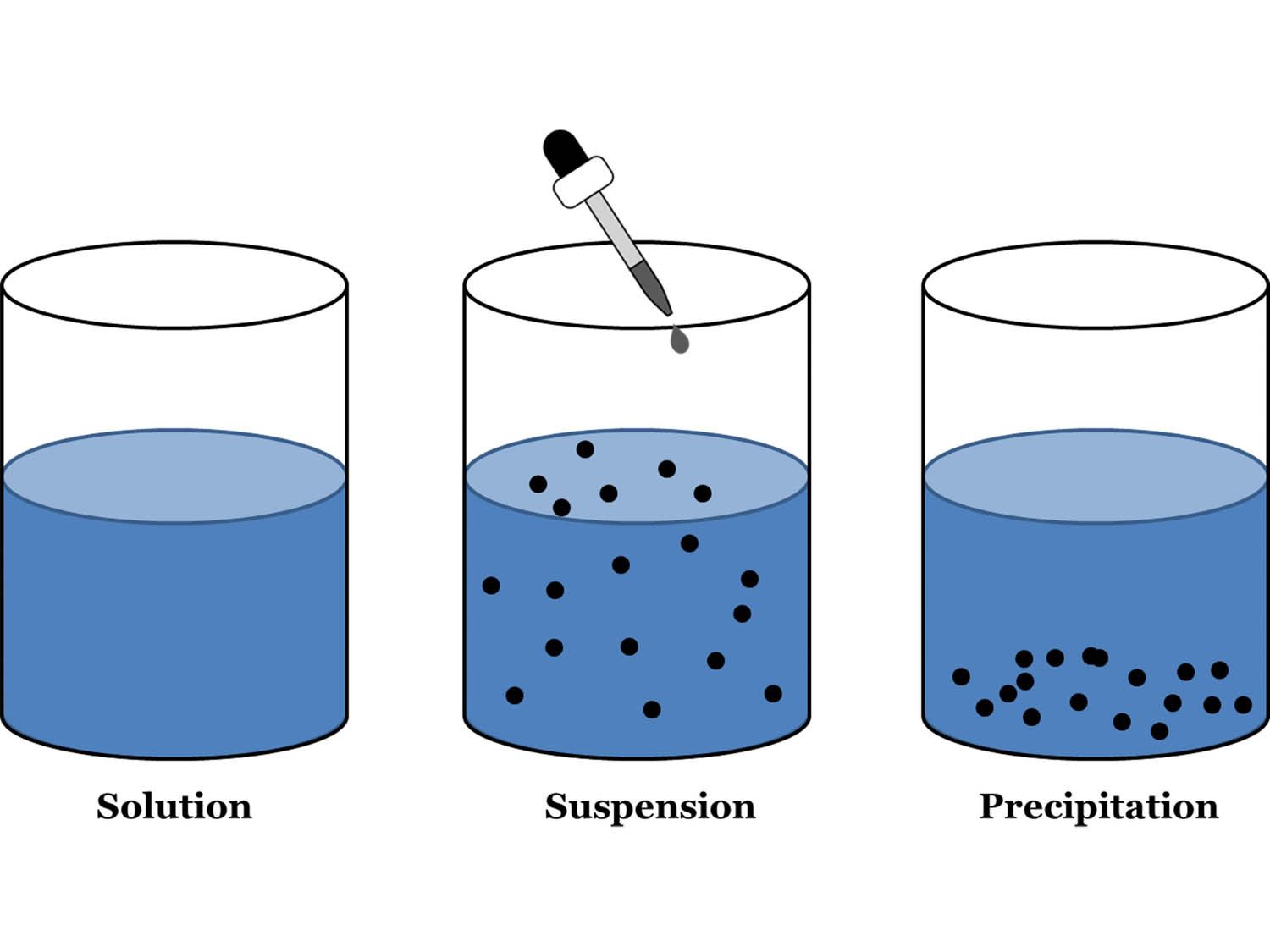
Solutions Colloids And Suspensions Worksheet
As nouns the difference between solution and suspension. is that solution is a homogeneous mixture, which may be liquid, gas or solid, formed by dissolving one or more substances while suspension is the act of suspending, or the state of being suspended.

Презентация на тему "Colloidal systems. Classes of solution True
Answer link. Suspensions are heterogeneous, solutions are homogeneous. Suspensions consist of more than one homogenous phase, for example, a suspension of clay particles in water consists of small solid particles suspended in liquid. A suspension of oil in water consists of two non-miscible liquid phases with a distinct interface between the.

What is the difference between a solution and a suspension? How are
Video transcript. Loading. Learn for free about math, art, computer programming, economics, physics, chemistry, biology, medicine, finance, history, and more. Khan Academy is a nonprofit with the mission of providing a free, world-class education for anyone, anywhere.

Difference Between Solutions and Suspensions, General Science Lecture
Suspension refers to a heterogeneous mixture in which solid particles or liquid droplets are dispersed in a liquid or gas. Unlike solutions, the particles in a suspension do not dissolve but remain suspended or floating. Examples of Suspensions: Muddy water (small soil particles suspended in water) Paint (pigments suspended in a liquid medium)

True Solution, Colloid solution and Suspension three different types of
Suspension vs Solution The solution is a homogeneous mixture of two or more substances, molecules, ions, or atoms dissolved in a solvent. A suspension is a heterogeneous mixture of two or more substances dispersed throughout a liquid or gas, with larger particles that are not fully dissolved.

Difference Between True Solutions, Colloidal solution and Suspension
Figure 7.6.1 7.6. 1: A mixture of sand and water forms a suspension. A suspension is a heterogeneous mixture in which some of the particles settle out of the mixture upon standing. The particles in a suspension are far larger than those of a solution, so gravity is able to pull them down out of the dispersion medium (water).
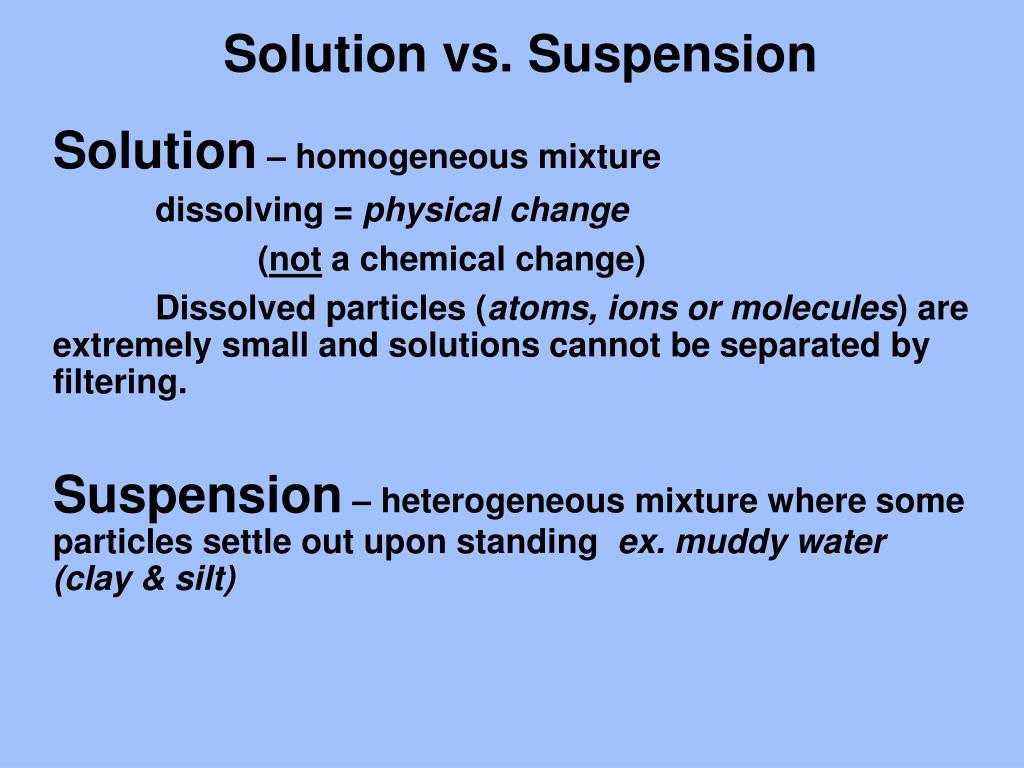
PPT What is a homogeneous mixture? PowerPoint Presentation, free
Main Difference - Solution vs Suspension Solutions and suspensions are both considered as mixtures. The key difference between solution and suspension is their particle size. Particles in a solution are much smaller than that of suspensions.

Solutions Suspensions and Colloids Part 1/1 English Class 9 YouTube
A solution is a homogeneous mixture of two or more components. The dissolving agent is the solvent. The substance that is dissolved is the solute. The components of a solution are atoms, ions, or molecules, making them 10 -9 m or smaller in diameter. Example: Sugar and water Suspensions
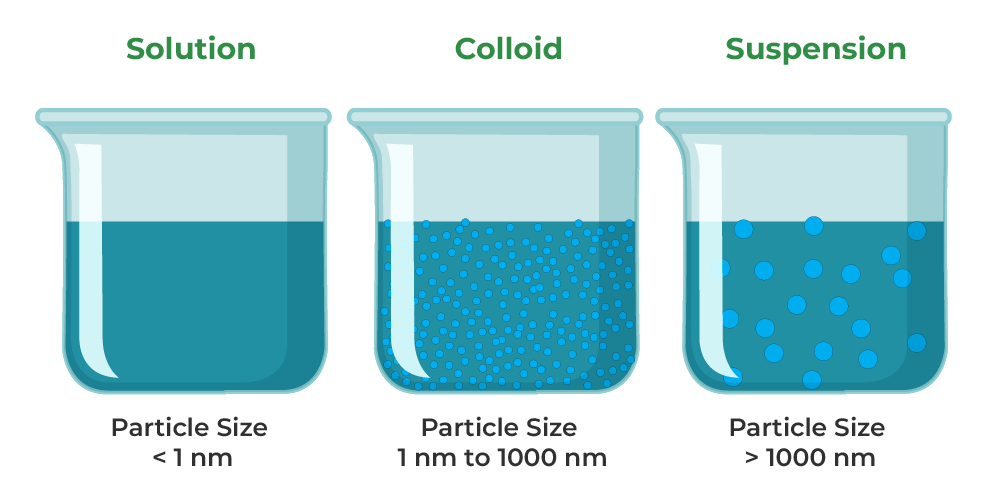
Suspension(Chemistry) Definition, Properties, Examples, and FAQs
The main difference between solution and suspension is that the solute particles can not be seen (by the naked eye) in solutions whereas, in suspensions, those particles can easily be seen. Solutions contain solute particles with a size of less than 1 nm while suspensions have solute particles that measure more than 1000 nm.
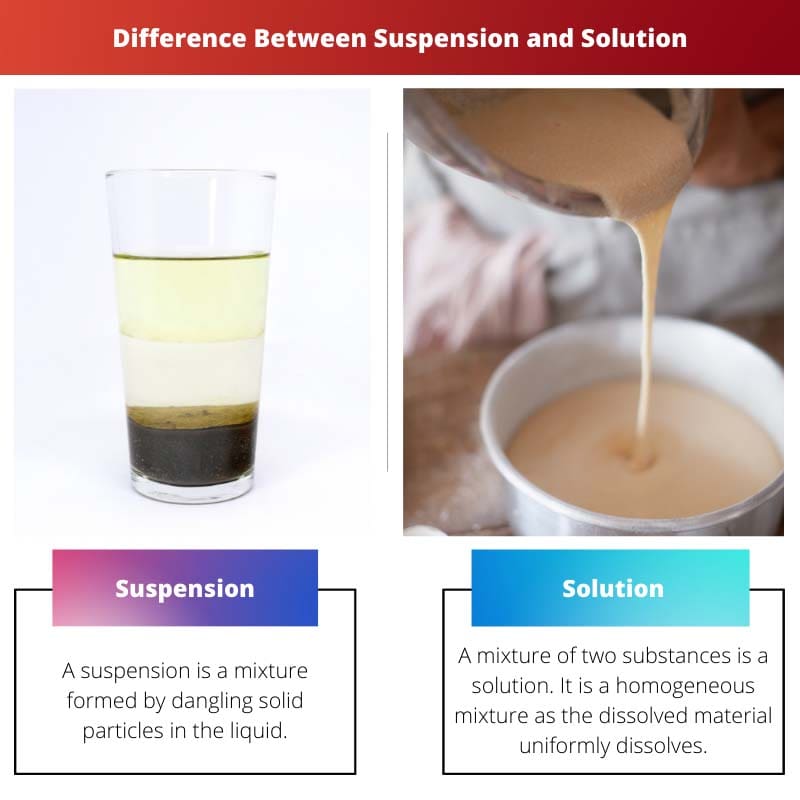
Suspension vs Solution Difference and Comparison
Answer 1: The difference between a solution and a suspension is in the particle sizes involved. A solution is a mixture of ions or molecules (very, very small). Solutions are transparent, meaning that you can see through them. A suspension has bigger particle sizes and so it may look cloudy or murky.

PPT Chemistry 102(01) Spring 2013 PowerPoint Presentation, free
1.Solutions are mixtures that are homogeneous while suspensions are mixtures that are heterogeneous. 2.The particles of a solution are at the ion or molecular level and cannot be seen by the naked eye while the particles of a suspension can be seen by the naked eye.